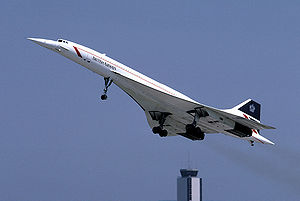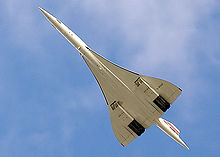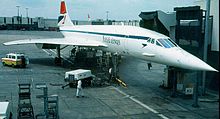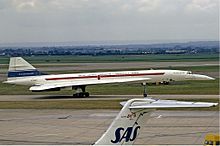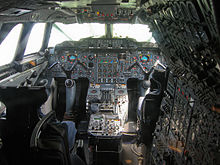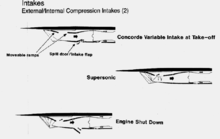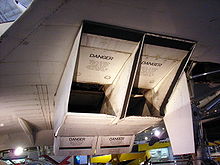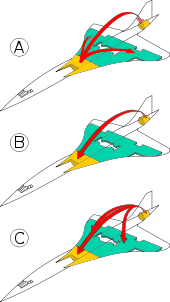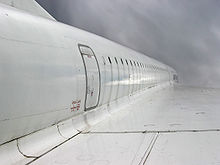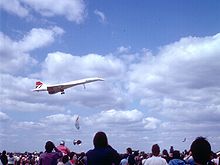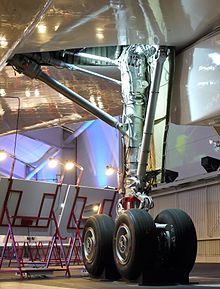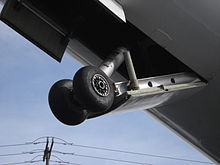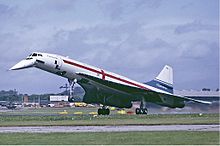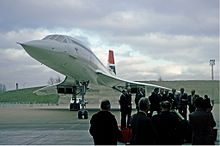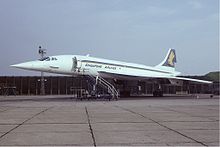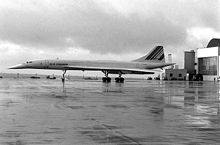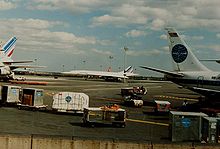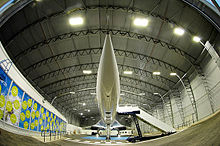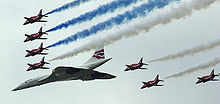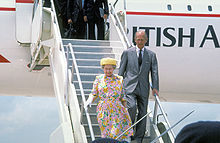
Concorde
About this schools Wikipedia selection
SOS Children, an education charity, organised this selection. To compare sponsorship charities this is the best sponsorship link.
| Concorde | |
|---|---|
| Role | Supersonic airliner |
| Manufacturer | BAC (now BAE Systems) Sud Aviation (later Aérospatiale, now EADS) |
| First flight | 2 March 1969 |
| Introduction | 21 January 1976 |
| Retired | 26 November 2003 |
| Status | Retired from service |
| Primary users | British Airways Air France See Operators below for others |
| Number built | 20 (including 6 non-airline aircraft) |
| Program cost | £ 1.3 billion |
| Unit cost | £ 23 million in 1977 (£ 107 million in 2013 pounds) |
Aérospatiale-BAC Concorde (pron.: / ˈ k ɒ ŋ k ɔr d /) is a retired turbojet-powered supersonic passenger airliner or supersonic transport (SST). It is one of only two SSTs to have entered commercial service; the other was the Tupolev Tu-144. Concorde was jointly developed and produced by Aérospatiale and the British Aircraft Corporation (BAC) under an Anglo-French treaty. First flown in 1969, Concorde entered service in 1976 and continued commercial flights for 27 years.
Among other destinations, Concorde flew regular transatlantic flights from London Heathrow and Paris-Charles de Gaulle Airport to New York JFK and Washington Dulles; it profitably flew these routes in less than half the time of other airliners. With only 20 aircraft built, the development of Concorde was a substantial economic loss; Air France and British Airways also received considerable government subsidies to purchase them. Concorde was retired in 2003 due to a general downturn in the aviation industry after the type's only crash in 2000, the 9/11 terrorist attacks in 2001 and a decision by Airbus, the successor firm of Aerospatiale and BAC, to discontinue maintenance support.
Concorde's name reflects the development agreement between the United Kingdom and France. In the UK, any or all of the type—unusual for an aircraft—are known simply as "Concorde", without an article. The aircraft is regarded by many people as an aviation icon and an engineering marvel.
Development
Concept
In the late 1950s, France, the United Kingdom, United States, and Soviet Union were considering developing supersonic transport. The British Bristol Aeroplane Company and the French Sud Aviation were both working on designs, called the Type 223 and Super-Caravelle, respectively. Both were largely funded by their respective governments. The British design was for a thin-winged delta shape (which owed much to work by Dietrich Küchemann, then at the Royal Aircraft Establishment) for a transatlantic-ranged aircraft for about 100 people, while the French were intending to build a medium-range aircraft.
The designs were both ready to start prototype construction in the early 1960s, but the cost was so great that the British government made it a requirement that British Aircraft Corporation (which had been formed in 1960 as a consolidation of British aircraft companies, including the Bristol Aeroplane Company) look for international co-operation. Approaches were made to a number of countries, but only France showed real interest. The development project was negotiated as an international treaty between the two countries rather than a commercial agreement between companies and included a clause, originally asked for by the UK, imposing heavy penalties for cancellation. A draft treaty was signed on 29 November 1962. By this time, both companies had been merged into new ones; thus, the Concorde project was between the British Aircraft Corporation and Aérospatiale. At first the new consortium intended to produce one long range and one short range version. However, prospective customers showed no interest in the short-range version and it was dropped. The consortium secured orders (i.e., non-binding options) for over 100 of the long-range version from the major airlines of the day: Pan Am, BOAC, and Air France were the launch customers, with six Concordes each. Other airlines in the order book included Panair do Brasil, Continental Airlines, Japan Airlines, Lufthansa, American Airlines, United Airlines, Air India, Air Canada, Braniff, Singapore Airlines, Iran Air, Olympic Airways, Qantas, CAAC, Middle East Airlines, and TWA.
The design work was supported by a preceding research programme studying the flight characteristics of low ratio delta wings. The supersonic BAC 221 was modified for flight tests of the high speed flight envelope, the Handley Page HP.115 also provided valuable information on low speed performance.
Naming
Reflecting the treaty between the British and French governments which led to Concorde's construction, the name Concorde is from the French word concorde (IPA: [kɔ̃kɔʁd]), which has an English equivalent, concord. Both words mean agreement, harmony or union.
The aircraft was initially referred to in the UK as Concorde, with the French spelling, but was officially changed to Concord by Harold Macmillan in response to a perceived slight by Charles de Gaulle. In 1967, at the French roll-out in Toulouse the British Government Minister for Technology, Tony Benn, announced that he would change the spelling back to Concorde. This created a nationalist uproar that died down when Benn stated that the suffixed ⟨e⟩ represented "Excellence, England, Europe and Entente (Cordiale)." In his memoirs, he recounts a tale of a letter from an irate Scotsman claiming: "[Y]ou talk about 'E' for England, but part of it is made in Scotland." Given Scotland’s contribution of providing the nose cone for the aircraft, Benn replied, "[I]t was also 'E' for ' Écosse' (the French name for Scotland) — and I might have added 'e' for extravagance and 'e' for escalation as well!"
Concorde also acquired an unusual nomenclature for an aircraft. In common usage in the United Kingdom, the type is known as Concorde without an article, rather than the Concorde or a Concorde.
Testing
Construction of two prototypes began in February 1965: 001, built by Aerospatiale at Toulouse, and 002, by BAC at Filton, Bristol. Concorde 001 made its first test flight from Toulouse on 2 March 1969, piloted by André Turcat, and first went supersonic on 1 October. The first UK-built Concorde flew from Filton to RAF Fairford on 9 April 1969, piloted by Brian Trubshaw. Both prototypes were presented to the public for the first time on 7–8 June 1969 at the Paris Airshow. As the flight programme progressed, 001 embarked on a sales and demonstration tour on 4 September 1971, which was also the first transatlantic crossing of Concorde. Concorde 002 followed suit on 2 June 1972 with a tour of the Middle and Far East. Concorde 002 made the first visit to the United States in 1973, landing at the new Dallas/Fort Worth Regional Airport to mark that airport’s opening.
While Concorde had initially held a great deal of customer interest, the project was hit by a large number of order cancellations. The Paris Le Bourget air show crash of the competing Soviet Tupolev Tu-144 had shocked potential buyers, and public concern over the environmental issues presented by a supersonic aircraft – the sonic boom, takeoff-noise and pollution – had produced a shift in public opinion of SSTs. By 1976 four nations remained as prospective buyers: Britain, France, China, and Iran. Only Air France and British Airways (the successor to BOAC) took up their orders, with the two governments taking a cut of any profits made.
The United States cancelled the Boeing 2707, its rival supersonic transport programme, in 1971. Observers have suggested that opposition to Concorde on grounds of noise pollution had been encouraged by the United States Government, as it lacked its own competitor. The US, India, and Malaysia all ruled out Concorde supersonic flights over the noise concern, although some of these restrictions were later relaxed. Professor Douglas Ross characterised restrictions placed upon Concorde operations by President Jimmy Carter's administration as having been an act of protectionism of American aircraft manufacturers.
Concorde had other considerable difficulties that led to its dismal sales performance. Costs had spiralled during development to more than six times the original projections, arriving at a unit cost of £23 million in 1977. World events had also dampened Concorde sales prospects, the 1973 oil crisis had many airlines think twice about aircraft with high rates of fuel-consumption; and new wide-body aircraft, such as the Boeing 747, had recently made subsonic aircraft significantly more efficient and presented a low-risk option for airlines. While carrying a full load, Concorde achieved 15.8 passenger miles per gallon of fuel, while the Boeing 707 reached 33.3 pm/g, the Boeing 747 46.4 pm/g, and the McDonnell Douglas DC-10 53.6 pm/g. An emerging trend in the industry in favour of cheaper airline tickets had also caused airlines such as Qantas to question Concorde's market suitability.
Design
General features
Concorde is an ogival (also "ogee") delta-winged aircraft with four Olympus engines based on those employed in the RAF's Avro Vulcan strategic bomber. Concorde was the first airliner to have a (in this case, analogue) fly-by-wire flight-control system; the avionics of Concorde were unique because it was the first commercial aircraft to employ hybrid circuits. The principal designer for the project was Pierre Satre, with Sir Archibald Russell as his deputy.
Concorde pioneered the following technologies:
For high speed and optimisation of flight:
- Double delta ( ogee/ogival) shaped wings
- Variable engine air intake system controlled by digital computers
- Supercruise capability
- Thrust-by-wire engines, predecessor of today’s FADEC-controlled engines
- Droop-nose section for better landing visibility
For weight-saving and enhanced performance:
- Mach 2.04 (~2,179 kilometres per hour / 1,354 mph) cruising speed for optimum fuel consumption (supersonic drag minimum although turbojet engines are more efficient at higher speed)
- Mainly aluminium construction for low weight and conventional manufacture (higher speeds would have ruled out aluminium)
- Full-regime autopilot and autothrottle allowing "hands off" control of the aircraft from climb out to landing
- Fully electrically controlled analogue fly-by-wire flight controls systems
- High-pressure hydraulic system of 28 MPa (4,000 lbf/in²) for lighter hydraulic components
- Complex Air Data Computer (ADC) for the automated monitoring and transmission of aerodynamic measurements (total pressure, static pressure, angle of attack, side-slip).
- Fully electrically controlled analogue brake-by-wire system
- Pitch trim by shifting fuel around the fuselage for centre-of-gravity control
- Parts made using " sculpture milling", reducing the part count while saving weight and adding strength.
- No auxiliary power unit, as Concorde would only visit large airports where ground air start carts are available.
Engines
Concorde needed to fly long distances to be economically viable; this required high efficiency. Turbofan engines were rejected due to their larger cross-section producing excessive drag. Turbojets were found to be the best choice of engines. The engine used was the twin spool Rolls-Royce/Snecma Olympus 593, a development of the Bristol engine first used for the Avro Vulcan bomber, and developed into an afterburning supersonic variant for the BAC TSR-2 strike bomber.
The aircraft used reheat ( afterburners) at takeoff and to pass through the transonic regime (i.e., "go supersonic") between Mach 0.95 and Mach 1.7. The afterburners were switched off at all other times. Due to jet engines being highly inefficient at low speeds, Concorde burned two tonnes of fuel (almost 2% of the maximum fuel load) taxiing to the runway. Fuel used is Jet A-1. Due to the high power produced even with the engines at idle, only the two outer engines were run after landing for easier taxiing.
The intake design for Concorde’s engines was especially critical. Conventional jet engines can take in air at only around Mach 0.5; therefore the air has to be slowed from the Mach 2.0 airspeed that enters the engine intake. In particular, Concorde needed to control the shock waves that this reduction in speed generates to avoid damage to the engines. This was done by a pair of intake ramps and an auxiliary spill door, whose position moved in-flight to slow transiting air.
Engine failure causes problems on conventional subsonic aircraft; not only does the aircraft lose thrust on that side but the engine creates drag, causing the aircraft to yaw and bank in the direction of the failed engine. If this had happened to Concorde at supersonic speeds, it theoretically could have caused a catastrophic failure of the airframe. Although computer simulations predicted considerable problems, in practice Concorde could shut down both engines on the same side of the aircraft at Mach 2 without the predicted difficulties. During an engine failure the required air intake is virtually zero so, on Concorde, engine failure was countered by the opening of the auxiliary spill door and the full extension of the ramps, which deflected the air downwards past the engine, gaining lift and minimising drag. Concorde pilots were routinely trained to handle double engine failure.
Heating issues
Air friction on the outer surfaces caused the cabin to heat up during flight. Every surface, such as windows and panels, was warm to the touch by end of the flight. Besides engines, the hottest part of the structure of any supersonic aircraft, due to aerodynamic heating, is the nose. The engineers used Hiduminium R.R. 58, an aluminium alloy, throughout the aircraft due to its familiarity, cost and ease of construction. The highest temperature that aluminium could sustain over the life of the aircraft was 127 °C (261 °F), which limited the top speed to Mach 2.02. Concorde went through two cycles of heating and cooling during a flight, first cooling down as it gained altitude, then heating up after going supersonic. The reverse happened when descending and slowing down. This had to be factored into the metallurgical and fatigue modelling. A test rig was built that repeatedly heated up a full-size section of the wing, and then cooled it, and periodically samples of metal were taken for testing.
Owing to air friction as the plane travelled at supersonic speed, the fuselage would heat up and expand by as much as 300 mm (almost 1 ft). The most obvious manifestation of this being a gap that opened up on the flight deck between the flight engineer's console and the bulkhead. On some aircraft that conducted a retiring supersonic flight, the flight engineers placed their caps in this expanded gap, wedging the cap when it shrank again. To keep the cabin cool, Concorde used the fuel as a heat sink for the heat from the air conditioning. The same method also cooled the hydraulics. During supersonic flight the surfaces forward from the cockpit became heated, and a visor was used to deflect much of this heat from directly reaching the cockpit.
Concorde had livery restrictions; the majority of the surface had to be covered with a highly reflective white paint to avoid overheating the aluminium structure due to heating effects from supersonic flight at Mach 2. In 1996, Air France briefly painted F-BTSD in a predominantly blue livery, with the exception of the wings, in a promotional deal with Pepsi. In this paint scheme, Air France were advised to remain at Mach 2 for no more than 20 minutes at a time, but there was no restriction at speeds under Mach 1.7. F-BTSD was used because it was not scheduled for any long flights that required extended Mach 2 operations.
Structural issues
Due to the high speeds at which Concorde travelled, large forces were applied to the aircraft's structure during banks and turns. This caused twisting and the distortion of the aircraft’s structure. In addition there were concerns over maintaining precise control at supersonic speeds; both of these issues were resolved by active ratio changes between the inboard and outboard elevons, varying at differing speeds including supersonic. Only the innermost elevons, which are attached to the stiffest area of the wings, were active at high speed. Additionally, the narrow fuselage meant that the aircraft flexed. This was visible from the rear passengers’ viewpoints.
When any aircraft passes the critical mach of that particular airframe, the centre of pressure shifts rearwards. This causes a pitch down force on the aircraft if the centre of mass remains where it was. The engineers designed the wings in a specific manner to reduce this shift, but there was still a shift of about 2 metres. This could have been countered by the use of trim controls, but at such high speeds this would have caused a dramatic increase in the drag on the aircraft. Instead, the distribution of fuel along the aircraft was shifted during acceleration and deceleration to move the centre of mass, effectively acting as an auxiliary trim control.
Range
In order to fly non-stop across the Atlantic Ocean, Concorde was developed to have the greatest supersonic range of any aircraft. This was achieved by a combination of engines which were highly efficient at supersonic speeds, a slender fuselage with high fineness ratio, and a complex wing shape for a high lift to drag ratio. This also required carrying only a modest payload and a high fuel capacity, and the aircraft was trimmed with precision to avoid unnecessary drag.
Nevertheless, soon after Concorde began flying, a Concorde "B" model was designed with slightly larger fuel capacity and slightly larger wings with leading edge slats to improve aerodynamic performance at all speeds, with the objective of expanding the range to reach markets in new regions. It featured more powerful engines with sound deadening and without the fuel-hungry and noisy reheat. It was speculated that it was reasonably possible to create an engine with up to 25% gain in efficiency over the Rolls-Royce/Snecma Olympus 593. This would have given 500 mi (805 km) additional range and a greater payload, making new commercial routes possible. This was cancelled due in part to poor sales of Concorde, but also to the rising cost of aviation fuel in the 1970s.
Cabin pressurisation and radiation concerns
The high altitude at which Concorde cruised meant passengers received almost twice the flux of extraterrestrial ionising radiation as those travelling on a conventional long-haul flight. Upon Concorde's introduction, it was speculated that this exposure during supersonic travels would increase the likelihood of skin cancer. Due to the proportionally reduced flight time, the overall equivalent dose would normally be less than a conventional flight over the same distance. Unusual solar activity might lead to an increase in incident radiation. To prevent incidents of excessive radiation exposure, the flight deck had a radiometer and an instrument to measure the rate of decrease of radiation. If the radiation level became too high, Concorde would descend below 47,000 feet (14,000 m).
Airliner cabins were usually maintained at a pressure equivalent to 6,000–8,000 feet (1,800–2,400 m) elevation. Concorde’s pressurisation was set to an altitude at the lower end of this range, 6,000 feet (1,800 m). Concorde’s maximum cruising altitude was 60,000 feet (18,000 m); subsonic airliners typically cruise below 40,000 feet (12,000 m).
A sudden reduction in cabin pressure is hazardous to all passengers and crew. Above 50,000 feet (15,000 m), in the event of a sudden cabin depressurisation, the lack of air pressure would give a " time of useful consciousness" in even a conditioned athlete of no more than 10–15 seconds. At Concorde’s altitude, the air density is very low; a breach of cabin integrity would result in a loss of pressure severe enough so that the plastic emergency oxygen masks installed on other passenger jets would not be effective, and passengers would quickly suffer from hypoxia despite quickly donning them. Concorde was equipped with smaller windows to reduce the rate of loss in the event of a breach, a reserve air supply system to augment cabin air pressure, and a rapid descent procedure to bring the aircraft to a safe altitude. The FAA enforces minimum emergency descent rates for aircraft and made note of Concorde’s higher operating altitude, concluding that the best response to a loss of pressure would be a rapid descent. Continuous positive airway pressure would have delivered pressurised oxygen directly to the pilots through masks.
Flight characteristics
While commercial jets take eight hours to fly from New York to Paris, the average supersonic flight time on the transatlantic routes was just under 3.5 hours. Concorde had a maximum cruise altitude of 18,300 metres (60,039 ft) and an average cruise speed of Mach 2.02, about 1155 knots (2140 km/h or 1334 mph), more than twice the speed of conventional aircraft.
With no other civil traffic operating at its cruising altitude of about 56,000 ft (17,000 m), dedicated oceanic airways or "tracks" were used by Concorde to cross the Atlantic. Due to the nature of high altitude winds, these SST tracks were fixed in terms of their co-ordinates, unlike the North Atlantic Tracks at lower altitudes whose co-ordinates alter daily according to forecast weather patterns. Concorde would also be cleared in a 15,000-foot (4,600 m) block, allowing for a slow climb from 45,000 to 60,000 ft (18,000 m) during the oceanic crossing as the fuel load gradually decreased. In regular service, Concorde employed an efficient cruise-climb flight profile following take-off.
The delta-shaped wings forced Concorde to attain a higher angle of attack at low speeds than conventional aircraft, but it allowed the formation of large low pressure vortices over the entire upper wing surface, maintaining lift. The normal landing speed was 170 miles per hour (274 km/h). Because of this high angle, during a landing approach Concorde was on the "back side" of the drag force curve, where raising the nose would increase the sink rate; the aircraft was thus largely flown on the throttle and was fitted with an autothrottle to reduce the pilot's workload.
Brakes and undercarriage
Because of the way Concorde's delta-wing generated lift, the undercarriage had to be unusually strong. At rotation, Concorde would rise to a high angle of attack, about 18 degrees. Prior to rotation the wing generated almost no lift, unlike typical aircraft wings. Combined with the high airspeed at rotation (199 knots indicated airspeed), this increased the stresses on the rear undercarriage in a way that was initially unexpected during the development and required a major redesign. Due to the high angle needed at rotation, a small set of wheels were added aft to prevent tailstrikes. The rear main undercarriage units swing towards each other to be stowed but due to their great height also need to retract telescopically before swinging in order to clear each other when stowed. The four main wheel tyres on each bogie unit are inflated to 232 lb/sq in. The twin-wheel nose undercarriage retracts forwards and its tyres are inflated to a pressure of 191 lb/sq in, and the wheel assembly carries a spray deflector to prevent standing water being thrown up into the engine intakes. The tyres are rated to 250 mph. The starboard nose wheel carries a single disc brake to halt wheel rotation whilst the undercarriage is being retracted. The port nose wheel carries speed generators for the anti-skid braking system which prevents brake activation until nose and main wheels are rotating at the same rate.
Additionally, due to the high average takeoff speed of 250 miles per hour (400 km/h), Concorde needed upgraded brakes. Like most airliners, Concorde has anti-skid braking – a system which prevents the tyres from losing traction when the brakes are applied for greater control during roll-out. The brakes, developed by Dunlop, were the first carbon-based brakes used on an airliner. The use of carbon over equivalent steel brakes provided a weight-saving of 12,000 lb (5,443 kg). Each wheel has multiple discs which are cooled by electric fans. Wheel sensors include brake overload, brake temperature, and tyre deflation. After a typical landing at Heathrow brake temperatures were around 300-400 c.
Droop nose
Concorde’s drooping nose, developed by Marshall Aerospace, enabled the aircraft to switch between being streamlined to reduce drag and achieve optimum aerodynamic efficiency, and not obstructing the pilot's view during taxi, takeoff, and landing operations. Due to the high angle of attack the long pointed nose obstructed the view and necessitated the capability to droop. The droop nose was accompanied by a moving visor that retracted into the nose prior to being lowered. When the nose was raised to horizontal, the visor would raise in front of the cockpit windscreen for aerodynamic streamlining.
A controller in the cockpit allowed the visor to be retracted and the nose to be lowered to 5° below the standard horizontal position for taxiing and takeoff. Following takeoff and after clearing the airport, the nose and visor were raised. Prior to landing, the visor was again retracted and the nose lowered to 12.5° below horizontal for maximum visibility. Upon landing the nose was raised to the five-degree position to avoid the possibility of damage.
The Federal Aviation Administration had objected to the restrictive visibility of the visor used on the first two prototype Concordes and thus requiring alteration before the FAA would permit Concorde to serve US airports; this led to the redesigned visor used on the production and the four pre-production aircraft (101, 102, 201, and 202). The nose window and visor glass needed to endure temperatures in excess of 100 °C at supersonic flight were developed by Triplex.
Operational history
Scheduled flights
Scheduled flights began on 21 January 1976 on the London–Bahrain and Paris–Rio (via Dakar) routes, with BA flights using the " Speedbird Concorde" call sign to notify air traffic control of the aircraft’s unique abilities and restrictions, but the French using their normal callsigns. The Paris-Caracas route (via Azores) began on 10 April. The US Congress had just banned Concorde landings in the US, mainly due to citizen protest over sonic booms, preventing launch on the coveted transatlantic routes. The US Secretary of Transportation, William Coleman, gave permission for Concorde service to Washington Dulles International Airport, and Air France and British Airways simultaneously began service to Dulles on 24 May 1976.
When the US ban on JFK Concorde operations was lifted in February 1977, New York banned Concorde locally. The ban came to an end on 17 October 1977 when the Supreme Court of the United States declined to overturn a lower court’s ruling rejecting efforts by the Port Authority and a grass-roots campaign led by Carol Berman to continue the ban. In spite of complaints about noise, the noise report noted that Air Force One, at the time a Boeing VC-137, was louder than Concorde at subsonic speeds and during takeoff and landing. Scheduled service from Paris and London to New York’s John F. Kennedy Airport began on 22 November 1977.
In 1977, British Airways and Singapore Airlines shared a Concorde for flights between London and Singapore International Airport at Paya Lebar via Bahrain. The aircraft, BA’s Concorde G-BOAD, was painted in Singapore Airlines livery on the port side and British Airways livery on the starboard side. The service was discontinued after three return flights because of noise complaints from the Malaysian government; it could only be reinstated on a new route bypassing Malaysian airspace in 1979. A dispute with India prevented Concorde from reaching supersonic speeds in Indian airspace, so the route was eventually declared not viable and discontinued in 1980.
During the Mexican oil boom, Air France flew Concorde twice weekly to Mexico City’s Benito Juárez International Airport via Washington, DC, or New York City, from September 1978 to November 1982. The worldwide economic crisis during that period resulted in this route’s cancellation; the last flights were almost empty. The routing between Washington or New York and Mexico City included a deceleration, from Mach 2.02 to Mach 0.95, to cross Florida subsonically and avoid creating a sonic boom over the state; Concorde then re-accelerated back to high speed while crossing the Gulf of Mexico. On 1 April 1989, on an around-the-world luxury tour charter, British Airways implemented changes to this routing that allowed G-BOAF to maintain Mach 2.02 by passing around Florida to the east and south. Periodically Concorde visited the region on similar chartered flights to Mexico City and Acapulco.
From 1978 to 1980, Braniff International Airways leased 10 Concordes, five each from Air France and British Airways. These were used on subsonic flights between Dallas-Fort Worth and Washington Dulles International Airport, flown by Braniff flight crews. Air France and British Airways crews then took over for the continuing supersonic flights to London and Paris. The aircraft were registered in both the United States and their home countries; the European registration was covered while being operated by Braniff, retaining full AF/BA liveries. The flights were not profitable and typically less than 50% booked, forcing Braniff to end its tenure as the only US Concorde operator in May 1980.
British Caledonian interest
Following the launch of British Airways' Concorde services, Britain's other major airline, British Caledonian (BCal), set up a task force headed by Gordon Davidson, BA's former Concorde director, to investigate the possibility of their own Concorde operations. This was seen as particularly viable for the airline's long-haul network as there were two unsold aircraft then available for purchase.
One important reason for BCal's interest in Concorde was that the British Government's 1976 aviation policy review had opened the possibility of BA setting up supersonic services in competition with BCal's established sphere of influence. To counteract this potential threat, BCal considered their own independent Concorde plans, as well as a partnership with BA. BCal were considered most likely to have set up a Concorde service on the Gatwick–Lagos route, a major source of revenue and profits within BCal's scheduled route network; BCal's Concorde task force did assess the viability of a daily supersonic service complementing the existing subsonic widebody service on this route.
BCal entered into a bid to acquire at least one Concorde. However, BCal eventually arranged for two aircraft to be leased from BA and Aérospatiale respectively, to be maintained by either BA or Air France. BCal's envisaged two-Concorde fleet would have required a high level of aircraft utilisation to be cost-effective; therefore, BCal had decided to operate the second aircraft on a supersonic service between Gatwick and Atlanta, with a stopover at either Gander or Halifax. Consideration was given to services to Houston and various points on its South American network at a later stage. Both supersonic services were to be launched at some point during 1980; however, steeply rising oil prices caused by the 1979 energy crisis led to BCal shelving their supersonic ambitions.
British Airways buys its Concordes outright
By around 1981 in the UK, the future for Concorde looked bleak. The British government had lost money operating Concorde every year, and moves were afoot to cancel the service entirely. A cost projection came back with greatly reduced metallurgical testing costs because the test rig for the wings had built up enough data to last for 30 years and could be shut down. Despite this, the government was not keen to continue. In 1983, BA's managing director, Sir John King, convinced the government to sell the aircraft outright to British Airways for £16.5 million plus the first year’s profits.
King recognised that, in Concorde, BA had a premier product that was underpriced. Market research had revealed that many customers thought Concorde was more expensive than it actually was; thus ticket prices were progressively raised to match these perceptions. It is reported that British Airways then ran Concorde at a profit, unlike their French counterpart.
Between 1984 and 1991, British Airways flew a thrice-weekly Concorde service between London and Miami, stopping at Washington Dulles International Airport. Until 2003, Air France and British Airways continued to operate the New York services daily. Concorde routinely flew to Grantley Adams International Airport, Barbados, during the winter holiday season.
Prior to the Air France Paris crash, several UK and French tour operators operated charter flights to European destinations on a regular basis; the charter business was viewed as lucrative by British Airways and Air France.
Concorde Flight 4590 crash
On 25 July 2000, Air France Flight 4590, registration F-BTSC, crashed in Gonesse, France after departing from Paris Charles de Gaulle en route to John F. Kennedy International Airport in New York City, killing all 100 passengers and nine crew members on board the flight, and four people on the ground. It was the only fatal accident involving Concorde.
According to the official investigation conducted by the Bureau d'Enquêtes et d'Analyses pour la Sécurité de l'Aviation Civile (BEA), the crash was caused by a titanium strip that fell from a Continental Airlines DC-10 that had taken off minutes earlier. This metal fragment punctured a tyre on Concorde's left main wheel bogie during takeoff. The tyre exploded, a piece of rubber hit the fuel tank, and while the fuel tank was not punctured, the impact caused a shock-wave which caused one of the fuel valves in the wing to burst open. This caused a major fuel leak from the tank, which then ignited due to sparking electrical landing gear wiring severed by another piece of the same tyre. The crew shut down engine number 2 in response to a fire warning, and with engine number 1 surging and producing little power, the aircraft was unable to gain height or speed. The aircraft entered a rapid pitch-up then a violent descent, rolling left and crashing tail-low into the Hôtelissimo Les Relais Bleus Hotel in Gonesse. On 6 December 2010, Continental Airlines and John Taylor, one of their mechanics, were found guilty of involuntary manslaughter, but on 30 November 2012 a French court overturned the conviction, saying mistakes by Continental and Taylor did not make them criminally responsible.
Prior to the accident, Concorde had been arguably the safest operational passenger airliner in the world in terms of passenger deaths-per-kilometres travelled with zero, but with a history of tyre explosions 60 times higher than subsonic jets. Safety improvements were made in the wake of the crash, including more secure electrical controls, Kevlar lining to the fuel tanks and specially developed burst-resistant tyres.
The first flight after the modifications departed from London Heathrow on 17 July 2001, piloted by BA Chief Concorde Pilot Mike Bannister. During the 3-hour 20-minute flight over the mid-Atlantic towards Iceland, Bannister attained Mach 2.02 and 60,000 ft (18,000 m) before returning to RAF Brize Norton. The test flight, intended to resemble the London–New York route, was declared a success and was watched on live TV, and by crowds on the ground at both locations. The first flight with passengers after the accident took place on 11 September 2001, which landed shortly before the World Trade Centre attacks in the United States. This was not a revenue flight, as all the passengers were BA employees.
Normal commercial operations resumed on 7 November 2001 by BA and AF (aircraft G-BOAE and F-BTSD), with service to New York JFK, where passengers were welcomed by then mayor Rudy Giuliani.
Retirement

On 10 April 2003, Air France and British Airways simultaneously announced that they would retire Concorde later that year. They cited low passenger numbers following the 25 July 2000 crash, the slump in air travel following 11 September 2001, and rising maintenance costs. Although Concorde was technologically advanced when introduced in the 1970s, 30 years later its analogue cockpit was dated. There had been little commercial pressure to upgrade Concorde due to a lack of competing aircraft, unlike other airliners of the same era such as the Boeing 747. By its retirement, it was the last aircraft in British Airways' fleet that had a flight engineer; other aircraft, such as the modernised 747-400, had eliminated the role.
Sir Richard Branson offered to buy British Airways’ Concorde fleet, first offering their nominal original price of £1 each, then increasing the offer to £1 million each. Branson claimed that when BA was privatised, a clause in the agreement required them to allow another British airline to operate Concorde if BA ceased to do so, but the Government denied the existence of such a clause. Branson wrote in The Economist (23 October 2003) that his final offer was "over £5 million" and that he had intended to operate the fleet "for many years to come". The chances for keeping Concorde in service were stifled by Airbus's lack of support for continued maintenance.
It has been suggested that Concorde was not withdrawn for the reasons usually given but that it became apparent during the grounding of Concorde that the airlines could make more profit carrying first class passengers subsonically. Rob Lewis suggested that the Air France retirement of its Concorde fleet was the result of a conspiracy between Air France Chairman Jean-Cyril Spinetta and Airbus CEO Noel Forgeard, and stemmed as much from a fear of being found criminally liable under French law for future Concorde accidents as from simple economics. A lack of commitment to Concorde from Director of Engineering Alan MacDonald was cited as having undermined BA’s resolve to continue operating Concorde.
Air France
Air France made its final commercial Concorde landing in the United States in New York City from Paris on 30 May 2003. Air France's final Concorde flight took place on 27 June 2003 when F-BVFC retired to Toulouse.
An auction of Concorde parts and memorabilia for Air France was held at Christie's in Paris on 15 November 2003; 1,300 people attended, and several lots exceeded their predicted values. French Concorde F-BVFC was retired to Toulouse and kept functional for a short time after the end of service, in case taxi runs were required in support of the French judicial enquiry into the 2000 crash. The aircraft is now fully retired and no longer functional.
French Concorde F-BTSD has been retired to the " Musée de l'Air et de l'Espace" at Le Bourget (near Paris) and, unlike the other museum Concordes, a few of the systems are being kept functional. For instance, the famous "droop nose" can still be lowered and raised. This led to rumours that they could be prepared for future flights for special occasions.
French Concorde F-BVFB currently rests at the Auto & Technik Museum Sinsheim at Sinsheim, Germany, after its last flight from Paris to Baden-Baden, followed by a spectacular transport to Sinsheim via barge and road. The museum also has a Tu-144 on display – this is the only place where both supersonic airliners can be seen together.
British Airways
British Airways conducted a North American farewell tour in October 2003. G-BOAG visited Toronto Pearson International Airport on 1 October, after which it flew to New York’s John F. Kennedy International Airport. G-BOAD visited Boston’s Logan International Airport on 8 October, and G-BOAG visited Washington Dulles International Airport on 14 October. It has been claimed that G-BOAD’s flight from London Heathrow to Boston set a transatlantic flight record of 3 hours, 5 minutes, 34 seconds. However the fastest transatlantic flight was from Heathrow to New York JFK airport on 7 February 1996, taking only 2 hours, 52 minutes, 59 seconds.
In a week of farewell flights around the United Kingdom, Concorde visited Birmingham on 20 October, Belfast on 21 October, Manchester on 22 October, Cardiff on 23 October, and Edinburgh on 24 October. Each day the aircraft made a return flight out and back into Heathrow to the cities, often overflying them at low altitude. On 22 October, both Concorde flight BA9021C, a special from Manchester, and BA002 from New York landed simultaneously on both of Heathrow's runways. On 23 October 2003, the Queen consented to the illumination of Windsor Castle, an honour reserved for state events and visiting dignitaries, as Concorde's last west-bound commercial flight departed London.
British Airways retired its Concorde fleet on 24 October. G-BOAG left New York to a fanfare similar to that given for Air France’s F-BTSD, while two more made round trips, G-BOAF over the Bay of Biscay, carrying VIP guests including former Concorde pilots, and G-BOAE to Edinburgh. The three aircraft then circled over London, having received special permission to fly at low altitude, before landing in sequence at Heathrow. The captain of the New York to London flight was Mike Bannister.
The final flight of a Concorde in the US occurred on 5 November 2003 when G-BOAG flew from New York's Kennedy Airport to Seattle's Boeing Field to join the Museum of Flight's permanent collection. The plane was piloted by Mike Bannister and Les Broadie who claimed a flight time of three hours, 55 minutes and 12 seconds, a record between the two cities. The museum had been pursuing a Concorde for their collection since 1984. The final flight of a Concorde world-wide took place on 26 November 2003 with a landing at Filton, Bristol, UK.
All of BA's Concorde fleet have been grounded, drained of hydraulic fluid and their airworthiness certificates withdrawn. Jock Lowe, ex-chief Concorde pilot and manager of the fleet estimated in 2004 that it would cost £10–15 million to make G-BOAF airworthy again. BA maintain ownership and have stated that they will not fly again due to a lack of support from Airbus. On 1 December 2003, Bonhams held an auction of British Airways’ Concorde artifacts, including a nose cone, at Kensington Olympia in London. Proceeds of around £750,000 were raised, with the majority going to charity. G-BOAD is currently on display at the Intrepid Sea, Air & Space Museum in New York. In 2007, BA announced that the advertising spot at Heathrow where a 40% scale model of Concorde was located would not be retained; the model is now on display at the Brooklands Museum.
Restoration
Although only used for spares after being retired from test flying and trials work in 1981, Concorde G-BBDG was dismantled and transported by road from Filton then restored from essentially a shell at the Brooklands Museum in Surrey.
One of the youngest Concordes (F-BTSD) is on display at Le Bourget Air and Space Museum in Paris. In February 2010, it was announced that the museum and a group of volunteer Air France technicians intend to restore F-BTSD so it can taxi under its own power. In May 2010, it was reported that the British Save Concorde Group and French Olympus 593 groups had begun inspecting the engines of a Concorde at the French museum; their intent is to restore the airliner to a condition where it can fly in demonstrations.
Comparable aircraft
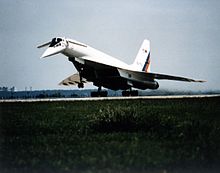
The only supersonic airliner in direct competition with Concorde was the Soviet Tupolev Tu-144, nicknamed "Concordski" by Western Europeans for its outward similarity to Concorde. It had been alleged that Soviet espionage efforts had resulted in the theft of Concorde blueprints, ostensibly to assist in the design of the Tu-144. As a result of a rushed development programme, the first Tu-144 prototype was substantially different from the preproduction machines, but both were cruder than Concorde. The Tu-144S had a significantly shorter range than Concorde, due to its low-bypass turbofan engines. The aircraft had poor control at low speeds because of a simpler supersonic wing design; in addition the Tu-144 required parachutes to land while Concorde used anti-lock brakes. The Tu-144 had two crashes, one at the 1973 Paris Air Show, and another during a pre-delivery test flight in May 1978.
Later production Tu-144 versions were more refined and competitive. They had retractable canards for better low-speed control, turbojet engines providing nearly the fuel efficiency and range of Concorde and a top speed of Mach 2.35. Passenger service commenced in November 1977, but after the 1978 crash the aircraft was taken out of service. The aircraft had an inherently unsafe structural design as a consequence of an automated production method chosen in order to simplify and speed up manufacturing.
The American designs, the Boeing 2707 and the Lockheed L-2000 were to have been larger, with seating for up to 300 people. Running a few years behind Concorde, the Boeing 2707 was redesigned to a cropped delta layout; the extra cost of these changes helped to kill the project. The operation of US military aircraft such as the XB-70 Valkyrie and B-58 Hustler had shown that sonic booms were quite capable of reaching the ground, and the experience from the Oklahoma City sonic boom tests led to the same environmental concerns that hindered the commercial success of Concorde. The American government cancelled the project in 1971, after having spent more than $1 billion.
The only other large supersonic aircraft comparable to Concorde are strategic bombers, principally the Russian Tupolev Tu-22, Tu-22M and Tu-160 and the American B-1 Lancer.
Impact
Environmental
Prior to Concorde’s flight trials, the developments made by the civil aviation industry were largely accepted by governments and their respective electorates. Opposition to Concorde’s noise, particularly on the east coast of the United States, forged a new political agenda on both sides of the Atlantic, with scientists and technology experts across a multitude of industries beginning to take the environmental and social impact more seriously. Although Concorde led directly to the introduction of a general noise abatement programme for aircraft flying out of John F. Kennedy Airport, many found that Concorde was quieter than expected, partly due to the pilots temporarily throttling back their engines to reduce noise during overflight of residential areas. Even before the launch of revenue earning services, it had been noted that Concorde was quieter than several aircraft already commonly in service at that time.
Concorde produced nitrogen oxides in its exhaust, which, despite complicated chemical interactions with other ozone-depleting chemicals, are understood to result in degradation to the ozone layer at the stratospheric altitudes it cruised. It has been pointed out that other, lower-flying, airliners produce ozone during their flights in the troposphere, but vertical transit of gases between the layers is restricted. The small fleet operated meant overall ozone-layer degradation caused by Concorde was negligible. David W. Fahey, of the National Oceanic and Atmospheric Administration, found that to produce a drop in stratospheric Ozone of 1 to 2% would require a fleet of 500 supersonic aircraft to be operated. Dr. Fahey stated that this would not be a limiting factor for further Supersonic Transport development.
Concorde’s technical leap forward boosted the public’s understanding of conflicts between technology and the environment as well as awareness of the complex decision analysis processes that surround such conflicts. In France, the use of acoustic fencing alongside TGV tracks might not have been achieved without the 1970s controversy over aircraft noise. In the UK, the CPRE has issued tranquillity maps since 1990.
Public perception
Concorde was normally perceived as a privilege of the rich, but special circular or one-way (with return by other flight or ship) charter flights were arranged to bring a trip within the means of moderately well-off enthusiasts.
The aircraft was usually referred to by the British as simply "Concorde". In France it was known as "le Concorde" due to "le", the definite article, used in French grammar to introduce the name of a ship or aircraft, and the capital being used to distinguish a proper name from a common noun of the same spelling. In French, the common noun concorde means "agreement, harmony, or peace". Concorde’s pilots and British Airways in official publications often refer to Concorde both in the singular and plural as "she" or "her".
As a symbol of national pride, an example from the BA fleet made occasional flypasts at selected Royal events, major air shows and other special occasions, sometimes in formation with the Red Arrows. On the final day of commercial service, public interest was so great that grandstands were erected at Heathrow Airport. Significant numbers of people attended the final landings; the event received widespread media coverage.
In 2006, 37 years after her first test flight, Concorde was announced the winner of the Great British Design Quest organised by the BBC and the Design Museum. A total of 212,000 votes were cast with Concorde beating design icons such as the Mini, mini skirt, Jaguar E-type, Tube map and the Supermarine Spitfire.
Records
The fastest transatlantic airliner flight was from New York JFK to London Heathrow on 7 February 1996 by British Airways' G-BOAD in 2 hours, 52 minutes, 59 seconds from takeoff to touchdown. Concorde also set other records, including the official FAI "Westbound Around the World" and "Eastbound Around the World" world air speed records. On 12–13 October 1992, in commemoration of the 500th anniversary of Columbus’ first New World landing, Concorde Spirit Tours (USA) chartered Air France Concorde F-BTSD and circumnavigated the world in 32 hours 49 minutes and 3 seconds, from Lisbon, Portugal, including six refuelling stops at Santo Domingo, Acapulco, Honolulu, Guam, Bangkok, and Bahrain.
The eastbound record was set by the same Air France Concorde (F-BTSD) under charter to Concorde Spirit Tours in the USA on 15–16 August 1995. This promotional flight circumnavigated the world from New York/JFK International Airport in 31 hours 27 minutes 49 seconds, including six refuelling stops at Toulouse, Dubai, Bangkok, Andersen AFB in Guam, Honolulu, and Acapulco. By its 30th flight anniversary on 2 March 1999 Concorde had clocked up 920,000 flight hours, with more than 600,000 supersonic, much more than all of the other supersonic aircraft in the Western world combined.
On its way to the Museum of Flight in November 2003, G-BOAG set a New York City-to-Seattle speed record of 3 hours, 55 minutes, and 12 seconds.
Replacements in development
The desire for a second-generation supersonic aircraft has remained within some elements of the aviation industry, and several concepts emerged quickly following the retirement of Concorde.
In November 2003, EADS—the parent company of Airbus—announced that it was considering working with Japanese companies to develop a larger, faster replacement for Concorde. In October 2005, JAXA, the Japan Aerospace eXploration Agency, undertook aerodynamic testing of a scale model of an airliner designed to carry 300 passengers at Mach 2 (working name NEXST). If pursued to commercial deployment, it would be expected to be in service around 2020–2025. On 18 June 2011, the Zero Emission High Speed Transport or ZEHST concept aircraft was unveiled by EADS at the Paris Air Show. The ZEHST, a hypersonic aircraft to be capable of 3,000 mph (4,800 km/h), is a result of the collaboration efforts between EADS and Japan.
The British company Reaction Engines Limited, with 50% EU money, has been engaged in a research programme called LAPCAT, which examined a design for a hydrogen-fuelled plane carrying 300 passengers called the A2, potentially capable of flying at Mach 5+ non-stop from Brussels to Sydney in 4.6 hours. The follow-on research effort, LAPCAT II began in 2008 and is to last four years.
In May 2008, it was reported that Aerion Corporation had $3 billion of pre-order sales on its Aerion SBJ supersonic business jet. In late 2010, the project continued with a testbed flight of a section of the wing.
Supersonic Aerospace International's Quiet Supersonic Transport was a 12 passenger design from Lockheed Martin that was to cruise at Mach 1.6, and was to have created a sonic boom only 1% as strong as that generated by Concorde.
Operators
- Air France
- British Airways
- Braniff International Airways (short term lease)
- Singapore Airlines (short term wet lease)
Specifications
Data from Wall Street Journal, The Concorde Story, The International Directory of Civil Aircraft, Richard Seamen aircraft museum
General characteristics
- Crew: 3 (2 Pilots and a flight engineer)
- Capacity: 92–120 passengers
(128 in high-density layout) - Length: 202 ft 4 in (61.66 m)
- Wingspan: 84 ft 0 in (25.6 m)
- Height: 40 ft 0 in (12.2 m)
- Fuselage internal length: 129 ft 0 in (39.32 m)
- Fuselage width: maximum of 9 ft 5 in (2.87 m) external 8 ft 7 in (2.62 m) internal
- Fuselage height: maximum of 10 ft 10 in (3.30 m) external 6 ft 5 in (1.96 m) internal)
- Wing area: 3,856 ft2 (358.25 m2)
- Empty weight: 173,500 lb (78,700 kg)
- Useful load: 245,000 lb (111,130 kg)
- Powerplant: 4 × Rolls-Royce/SNECMA Olympus 593 Mk 610 afterburning turbojets
- Dry thrust: 32,000 lbf (140 kN) each
- Thrust with afterburner: 38,050 lbf (169 kN) each
- Maximum fuel load: 210,940 lb (95,680 kg)
- Maximum taxiing weight: 412,000 lb (187,000 kg)
Performance
- Maximum speed: Mach 2.04 (≈1,354 mph, 2,179 km/h) at cruise altitude
- Cruise speed: Mach 2.02 (≈1,340 mph, 2,158 km/h) at cruise altitude
- Range: 3,900 nmi (4,500 mi, 7,250 km)
- Service ceiling: 60,000 ft (18,300 m)
- Rate of climb: 5,000 ft/min (25.41 m/s)
- lift-to-drag: Low speed– 3.94, Approach– 4.35, 250 kn, 10,000 ft– 9.27, Mach 0.94– 11.47, Mach 2.04– 7.14
- Fuel consumption: 46.85 lb/mi (13.2 kg/km) operating for maximum range
- Thrust/weight: 0.373
- Maximum nose tip temperature: 260 °F (127 °C)
